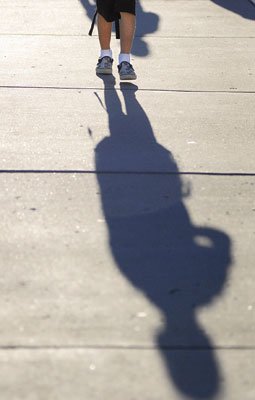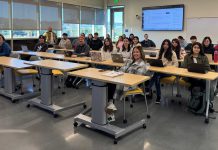District staff have a dream: 50 percent of students walking or
biking to school. With about 78 percent of students currently being
ferried to school by bus or private car, staff has an arduous road
ahead.
Gilroy – District staff have a dream: 50 percent of students walking or biking to school. With about 78 percent of students currently being ferried to school by bus or private car, staff has an arduous road ahead.
Gilroy Unified School District staff took one step closer Wednesday to realizing that goal by participating in International Walk to School Day. Staff at Luigi Aprea, Glen View and Rod Kelley elementary schools encouraged students to hit the streets in hopes of promoting healthy practices that would reduce traffic congestion, pedestrian hazards and the community’s environmental footprint.
Walk-in students increased significantly, making the day a jumping-off point for possibly netting $1.5 million in federal funds to further encourage walking to school, according to staff and one school’s data.
The event “exceeded my expectations,” said Principal-at-Large Joseph Di Salvo, who organized the day and was on-hand at Luigi Aprea to high-five students as they walked through a blue-and-white balloon arch.
At Rod Kelley, 341 students walked to school – 53 percent more than average. Staff also reported less traffic congestion at Glen View and Luigi Aprea.
The effects of a day focused on walking to school are manifold, district staff said. Staff said walking promotes exercise, integral to reducing Gilroy’s childhood obesity rate, which led Santa Clara County in 2004 with 31 percent, according to kidsdata.org.
Students responded positively to the idea of exercise. Six-year-old Alex Freudig – who biked to work with 9-year-old sister Ashley and father Vince – said he preferred biking the 10 minutes to school.
The family does not regularly bike to school because it can be a time hassle, Vince Freudig said.
“You’ve got to plan ahead for it, get out of the door earlier,” he said.
The event also eased traffic, which reduced gasoline consumption, greenhouse gas emissions and pedestrian hazards, staff said. Child safety is a major community concern as drivers hit three children – two of whom were walking to school and two of whom died – in the past 16 months.
Superintendent Deborah Flores, who greeted families at Luigi Aprea, recalled her childhood, when she walked up to two miles with her four younger siblings in what she joked was a “walking school bus.”
“It was a different time,” said the 54-year-old educator, who grew up in the Southwest. “We didn’t have as many cars on the road. There weren’t as many concerns about child safety, strangers approaching students.”
There have been five sexual assaults reported since mid-April, one of which occurred on Brownell Middle School campus and one of which involved a 16-year-old female victim on the levee behind Gilroy High School.
One family not participating in the walking festivities cited time pressures as an excuse, not safety concerns.
“I like to show (my children) the route to and from school, how they use the crosswalk,” but time is an issue, said Angela Flores, who drives her three children to school about every other day, including Wednesday.
After she drops off her two older children, she has only 45 minutes to get ready for work and drop off her 3-year-old at daycare.
Staff are hoping families will take the extra time to pitch in and increase student safety. The more families that walk to school, the fewer cars that will be on the road to cause accidents, Flores said. In addition, the more adults on the streets, the more the community can come together and keep streets safe, said Luigi Aprea Principal Richard Rodriguez, who walked about one mile each way during his school days in Salinas.
City and district staff will use witness accounts and Rod Kelley’s data to apply for for two grants, Di Salvo said. If they win both, they could have $500,000 to educate students and encourage them to walk to school as well as $1 million to make infrastructure improvements such as speed bumps. District staff hope the grants will help them get half of students walking to school, a level schools nationwide have not been at since 1969, Di Salvo said.
Flores plans to expand the program – in which schools volunteered to participate and which costs $200 for refreshments and stickers – in future years. The district has a lot of ground to make up, but the walking day was necessary first step, she said.
These practices “might become institutionalized if you do them often enough,” she said.













